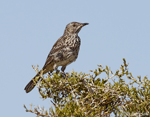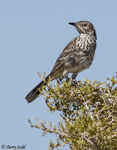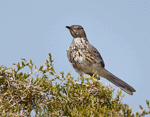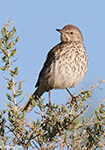Sage Thrasher
Oreoscoptes montanus
| Length: 8.5 inches | Wingspan: 11.5 inches | Seasonality: Summer |
| ID Keys: Grayish upperparts, white underparts with heavy streaking, yellow eyes, short straight bill | ||
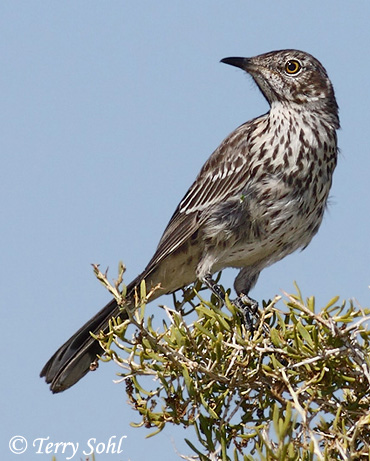 The
aptly named Sage Thrasher is indeed a denizen of sagebrush habitats, and is
rarely found outside that habitat during the summer breeding season. They
are restricted to the extreme western edge of South Dakota in the few remaining
areas of suitable sagebrush found in the state. Extremely shy birds, they
are likely to move into dense cover or to run away under the sagebrush canopy
when approached. They are the smallest of the Thrasher species found in
the western United States.
The
aptly named Sage Thrasher is indeed a denizen of sagebrush habitats, and is
rarely found outside that habitat during the summer breeding season. They
are restricted to the extreme western edge of South Dakota in the few remaining
areas of suitable sagebrush found in the state. Extremely shy birds, they
are likely to move into dense cover or to run away under the sagebrush canopy
when approached. They are the smallest of the Thrasher species found in
the western United States.
Habitat:
Breeds almost exclusively in sagebrush habitats. Can be found in other brushy or semi-open habitats in winter and in migration, especially in areas where berries are readily available.
Diet:
Primarily feeds on insects in summer months in South Dakota, especially grasshoppers, caterpillars, and beetles. Will also feed on fruits and berries, especially in the winter.
Behavior:
Primarily forages on the ground, although Sage Thrashers will also feed up in low bushes and scrub.
Nesting:
June and July. The nest of a Sage Thrasher is placed near the base of a large sagebrush plant, typically on the ground under thick cover or very low in the shrub itself. The nest is built of twigs, bark, and leaves, lined with finer material such as grasses or animal hair. The female lays 4 to 7 eggs, with both parents helping to incubate the eggs. The eggs hatch after about 14-16 days, with the young fledgling from the nest about 10-14 days after hatching.
Song:
Repeated clear warbling phrases. They also have a short chuk call.
1Click here to hear the warbling song of a singing Sage Thrasher
2Click here to hear the chuk call of a Sage Thrasher
Migration:
Summers throughout sagebrush habitat in the western United States. Migrates southward in the winter to the southwestern U.S. and Mexico.
Interactive eBird Map:
Click here to access an interactive eBird map of Sage Thrasher sightings
Feeders:
Will occasionally attend feeders for suet, seeds, and nuts
Similar Species:
Possibly confused with other thrasher species in range:
- Curve-billed Thrasher - Both species can sometimes be found in the same general area. The obvious distinguishing feature is the larger, strongly curved bill of the Curve-billed Thrasher. Curve-billed Thrashers are also generally darker overall (compared to the often pale looking Sage Thrasher). Curve-billed Thrashers also have a buffy colored undertail region lacking on the Sage Thrasher.
- Bendire's Thrasher - While they have a relatively small range in the United States there is some range overlap with the Sage Thrasher. Both species have an overall similar appearance, and unlike the Curve-billed Thrasher above, the bill isn't dramatically different than that of a Sage Thrasher. It is slightly more downcurved than a Sage Thrasher. The spotting on the underparts is somewhat less contrasty with the lighter color base than the high contrast on a Sage Thrasher. Individual dark spots are also fainter and less streaky-looking than those on a Sage Thrasher.
Conservation Status:
Like other species dependent upon sagebrush habitats, their numbers have diminished with the clearing and conversion of sagebrush habitats to rangeland or other land cover types. However, they are still found across a broad geographic range and are relatively common in parts of that range. The IUCN considers the Sage Thrasher to be a species of "Least Concern".
Further Information:
3) Audubon Guide - Sage Thrasher
Photo Information:
Photo taken on July 27th, 2009 - Antelope Island, near Salt Lake City, Utah - Terry Sohl
Additional Photos:
Click on the image links below for additional Sage Thrasher photos.
Audio File Credits:
1Ian Cruickshank - Recorded in British Columbia on June 29th, 2010. Original file and recording from xeno-canto.
2Tayler Brooks - Recorded in Colorado on May 15th, 2012. Original file and recording from xeno-canto.
| Click on the map below for a higher-resolution view |
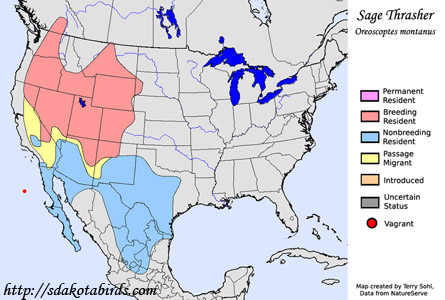 |
| South Dakota Status: Uncommon and local summer resident in portions of the extreme western part of the state. |
Additional Sage Thrasher Photos
Click for a higher-resolution version of these photos
